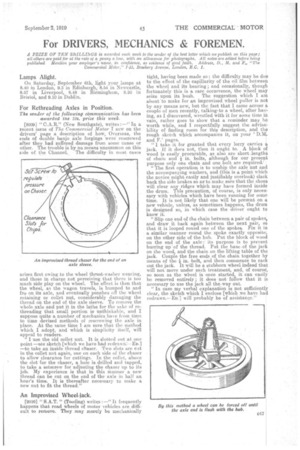For DRIVERS, MECHANICS & FOREMEN.
Page 21

If you've noticed an error in this article please click here to report it so we can fix it.
A PBIZE OF TEN SHILLINGS is awarded each week all others are paid for at the rate of a penny a line, with an published Mention your employer's name, in confidence, Commercial Motor," 7-11i, lb
Lamps Alight.
On Saturday, September 6th, light your lamps at 8.40 in London, 9.3 in Edinburgh, 8.54 in Newcastle, 8.57 in Liverpool, 8.48 in Birmingham, 8.50 in Bristol, and 9.10 in Dublin.
For Rethreading Axles in Position.
The sender of the following di mmunication has been awarded the 10s. prize this week.
[2009] " C.A.R." (New Southgate), writes ;—" In a recent issue of The Commercial Motor I saw on the drivers' page a description of how, Overseas, the ends of double banjo axle forgings were rescrewed after they had suffered damage from some cause or other. The trouble is by no means uncommon on this side of the Channel. The difficulty in most cases
arises first owing to the wheel thrust-washer wearing, and those in charge not perceiving that there is too much side play on the wheel. The effect is then that the wheel, as the wagon travels, is bumped to and fro on its axle, and eventually punches off the wheel retaining or collet nut, considerably damaging the thread on the end of the axle sleeve. To remove the whole axle and put it in the lathe for the sake of rethreading that small portion is unthinkable, and I suppose quite a number of mechanics have from time to time devised methods of rescrewing the axle in place. At the same time I am sure that the method which. I adopt, and which is simplicity itself, will appeal to readers.
" I use the old collet nut. It is slotted out at one point —see sketch [which we have had redrawn:— En.] —to take an inside :thread chaser. -Two slots are cut in the collet nut again, one on each side of the chaser to allow clearance for cuttings. In the collet, above the slot for the chaser, a hole is drilled and tapped, to take a setscrew for adjusting the chaser up to its job. My experience is that in this Manner a. new thread can be cut on the end of the axle in half an hour's time. It is thereafter necessary to make a new nut to fit. the thread."
An Improvised Wheel-jack.
[2010] " S.A.T. " (Toofing) writes :—" It frequently happens that road wheels of motor vehicles are difficult to remove. They may merely be mechanically
to the sender of the best letter which we publish on this page ; allowance for photographs. All notes are edited before being as evidence of good faith. Address, D., M. and F., "The sebery Avenue, London, E.C. 1.
tight, having been made so : the difficulty may be du to the effect of the capillarity of the oil film bctwee the wheel and its hearing; and occasionally, thong fortunately this is a rare occurrence, the wheel ma seize upon its bush. The suggestion which I a about to make for an improvised wheel puller is no by any means new, but the fact that I came across couple of men recently, talking.to a wheel, after ha ing, as I discovered, wrestled with it for some time in vain, rather goes to show that a reminder may b worth while, and I respectfully suggest the advis bility of finding room for this description, and th rough sketch which accompanies it, on your 'D. and F.' pages. "I. take it for granted that every lorry carries it jack. If it does not, then it ought to. A block of wood is easily procurable, as also are short.lengthis of chain and in. bolts, although for our present purpose only one chain and one bolt are required.
"The first operation is to unship the axle nut and the accompanying washers, and (this is a point which the novice might easily and justifiably overlook) slack back the side brakes so as to make sure that the shoes will clear any ridges which may have formed inside the drum. n78 precaution, of course, is only necessary with vehicles which have been running for some time. It is not likely that one will be present on a new vehicle, unless, as sometimes happens, the drum is designed so, in which case the driver ought to know it.
"Slip one end of the chain between a pair of spokeS, and draw it back again between the next pair so that it is looped round one of the spokes. Fix it in a similar manner round the spoke exactly opposite, on the other side of the hub. Put the block of wood on the end of the axle :. its purpose is to prevent burring up of the thread. Put the base-of the jack on the wood, and the chain on the lifting table of the jack. Couple the free ends of the chain together by means of the in. bolt, and then commence to rack out the jack. It will be a stubborn wheel indeed that -will not move under such treatment, and, of courser, so soon as the wheel is once started, it can easilY be removed entirely; it does not follow that it is necessary to use the jack all the•way out. "In case my verbal explanation is not sufficiently clear, the sketch which I enclose [which we have had redrawn..--En]-will probably be of assistance"






















